8 Mar 2013 | Uncategorized
Twenty years ago, at the UN Conference on Human Rights in Vienna, an extraordinary group of women activists forced the human rights movement to confont the sexism that had shaped their agenda until that time. The promise of Vienna was that the access to rights enshrined in the Universal Declaration would be made explicit in relation to women and gender.
The conference declaration said: “All human rights are universal, indivisible and interdependent and interrelated. The international community must treat human rights globally in a fair and equal manner, on the same footing, and with the same emphasis.” It went into considerable detail about what this means for women.
However the Vienna Declaration said very little about free expression. Nor was this omission rectified in the Beijing Declaration on Women’s Rights in 1995. The year before, after serving as founding chair of the International PEN Women Writers Committee, I had become President of a new organisation, Women’s WORLD (Women’s World Organisation for Rights, Literature and Development).
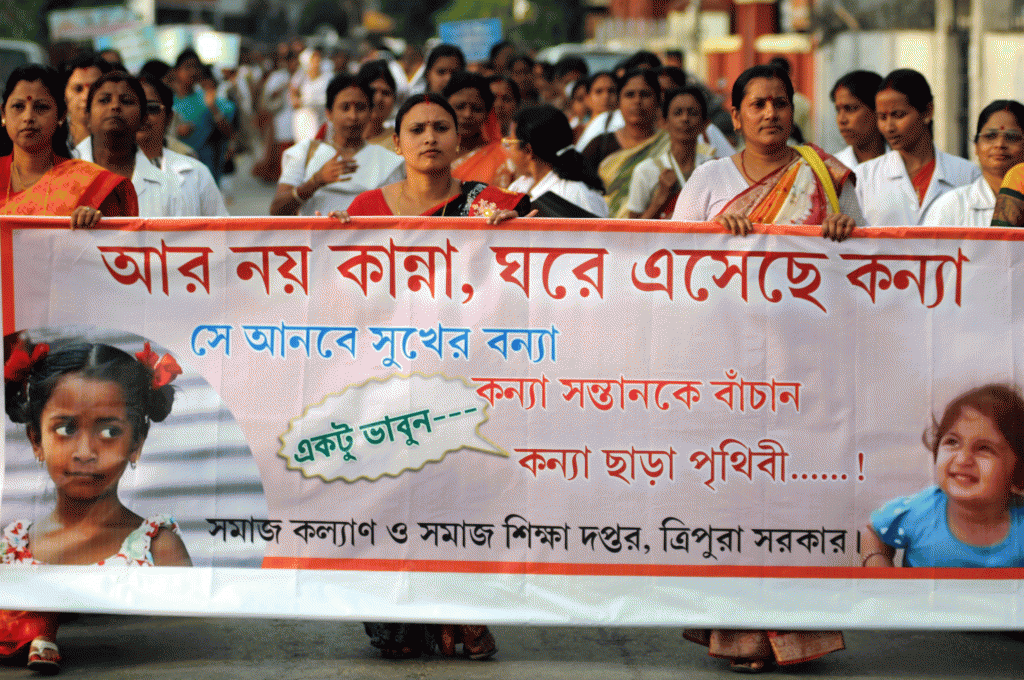
Women hold a banner to ‘Save the Girl Child’ during a 2012 International Women’s Day rally in Agartala
Women’s WORLD was set up to investigate and advocate against gender-based censorship, both formal and informal, and to defend feminist writers. We prepared a document for Beijing called The Power of the Word: Culture, Censorship and Voice, emphasising the importance of voice and thus of women writers to the struggle for women’s equality:
“The subordination of women is basic to all social systems based on dominance; for this reason, conservatives hate and fear the voices of women. That is why so many religions have made rules against women preaching or even speaking in the house of worship. That is why governments keep telling women to keep quiet: ‘You’re in the Constitution,’ they will say, ‘you have the vote, so you have no right to complain.’ But having a voice is as important, perhaps more important, than having a vote. When censors attack women writers, they do so in order to intimidate all women and keep them from using their right to free expression. Gender-based censorship is therefore a problem not only for women writers, but for everyone concerned with the emancipation of women.
“Women writers are a threat to systems built on gender hierarchy because they open doors for other women. By expressing the painful contradictions between men and women in their society, by exposing the discrepancy between what society requires of women and what they need to be fulfilled, woman writers challenge the status quo…[and] make a breach in the wall of silence. They say things no one has ever said before and say them in print, where anyone can read and repeat them.”
As President of Women’s WORLD, I produced an analysis of the Declaration and Platform for Action that came out of the Beijing Conference. While recognising the Platform of Action was a huge step forward in translating women’s issues into the language of human rights, I concluded that it fell short in the area of free expression, for these reasons:
- The Platform of Action did not consider the centrality of voice to female emancipation. It did not mention censorship nor recognise that women’s right to free expression is jeopardised in many parts of the world, and that the silencing of women is a barrier to both development and democracy.
- With the exception of indigenous women, who were seen to have a culture and the right to develop it, the Platform of Action framed culture in negative terms, as something that limited women’s rights rather than as something women make, transmit, and shape.
- The Platform of Action’s main concern with media was in terms of harmful portrayals of women, with some slight emphasis on the need for women to have access to the new electronic media. Nowhere did it mention that free expression is not only a right but the means to protect other rights, nor the social contributions women could make if their voices were not continually suppressed.
Our paper for Beijing said, “While there is no question that indigenous and colonised peoples are under particular cultural assault, all women need cultural rights. We need the time and space and access to means of cultural expression to be able to articulate our own social values. Without attention to culture, sustainable development and real democracy are not possible, because profound changes must necessarily be culture-related. Women’s silence is thus as serious a problem as poverty itself, and is both a cause of poverty and its effect.”
In the years after 1995, Women’s WORLD struggled to raise issues of voice but kept running up against a narrowing of women’s human rights to the issue of violence against women, while we were striving for a more inclusive vision that would connect this violence to culture, religion, economics, power politics, censorship and war. Our work was also affected by a separation within the human rights movement between groups that deal mainly with free expression and the big mainstream multi-issue groups.
This same separation was reflected in the global movement for women’s human rights. For instance, when the Women’s Human Rights Defenders International Coalition released a global report in 2012 on dangers facing feminists in various regions, it did not even think of drawing on the many years of experience of groups that defend writers and journalists, many of whom are women.
In the last few years, the global women’s movement has found itself stonewalled by the rise of religious fundamentalism to the degree that many activists now oppose moves for another UN conference on women, fearing that the gains of the 90s will be undermined.
The UN Council on Human Rights has been a battleground over issues of culture, with a newly religious Russia forming a bloc with many African and Muslim-majority countries, to support a resolution calling for the application of the “traditional values of humankind” to human rights norms. Such “traditional values” are, of course, invoked whenever women, sexual minorities, or religious minorities want equal rights, including the right to free expression.
In the darkness of this backlash against women’s human rights, the UN’s 2009 appointment of Pakistani feminist Farida Shaheed, first as an independent expert and now as the special rapporteur in the field of cultural rights, was one of the few rays of light. In her 2012 report, Shaheed flagged ways in which fundamentalism impinges on women’s exercise of their cultural rights, as when “solo female singing has been banned and restrictions have been placed on female musicians performing in public concerts.”
She linked culture to violence against women, pointing out that when women try to deviate from the dominant culture of their communities or interpret and reshape them, “they often confront disproportionate opposition, including different forms of violence, for acts as apparently simple as choosing who to marry, how to dress, or where to go.”
She has taken a proactive approach to women’s cultural production, shifting the perspective from seeing culture as an obstacle to women’s human rights to ensuring that women have equal cultural rights. Hopefully her work as special rapporteur will help turn back the proponants of the “traditional values of mankind,” and encourage a wider recognition that freedom of expression is critical to equality for women.
Meredith Tax, an American writer and activist, is Chair of the Board of the Centre for Secular Space, a new thinktank based in London http://www.meredithtax.org/
1 Mar 2013 | News and features, Religion and Culture
[vc_row][vc_column][vc_column_text]While they exist harmoniously on paper, free expression and religion often conflict in practice, and free speech is often trampled in the name of protecting religious sensibilities — whether through self-censorship or legislation that censors.
History offers many examples of religious freedom being repressed too. Both free expression and religious freedom need protection from those who would meddle with them. And they are not necessarily incompatible.
Over 200 years ago, the United States’ founding fathers grouped together freedom of worship and freedom of speech. The US Constitution’s First Amendment, adopted in 1791, made sure that the Congress couldn’t pass laws establishing religions or prohibiting their free exercise, or abridging freedom of speech, press and assembly.
More recently, both religion and free expression were offered protection by The United Nations Declaration of Human Rights (UNDHR) drafted in 1949. It outlines the ways in which both free expression and religious freedom should be protected in Articles 18 and 19. Article 18 protects an individual’s right to “freedom of thought, conscience, and religion” and the freedom to change religion or beliefs. Article 19 states: “Everyone has the right to freedom of opinion and expression; this right includes freedom to hold opinions without interference and to seek, receive and impart information and ideas through any media and regardless of frontiers.”
Why is it, then, that for centuries — from the Spanish Inquisition to the Satanic Verses — free speech and religion have been cast as opponents? Index on Censorship has explored, and will continue to explore, this crucial question.
Offence
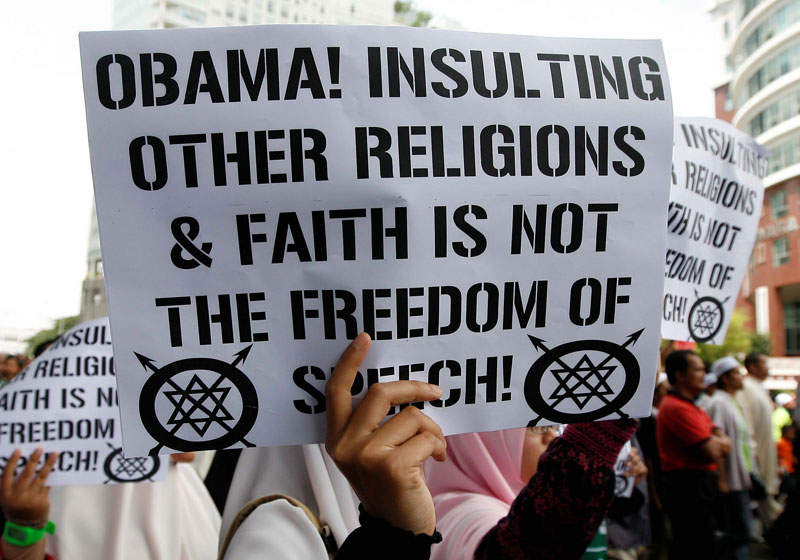
Muslims gathered in Malaysia’s capital to protest against the controversial Innocence of Muslims film (Demotix)
Sporadically explosive conflicts arrise when words or images offensive to believers spark a violent response, the most recent example being the reaction to the controversial Innocence of Muslims film. Index has stated before that the majority of states restrain by law distinct and direct incitements to violence; however, causing offence doesn’t constitute an incitement to violence, much less a good excuse to react with violence. Yet violent protests sparked by the YouTube film led many countries to push for the video to be taken down. As the controversy unfolded, digital platforms took centre stage in an age-old debate on where the line is drawn on free speech.
The kind of connectivity provided by the web means a video uploaded in California can lead to riots in Cairo. Real-time transmission, real-time unrest. It presents a serious challenge for hosts of user-generated content like YouTube and Facebook.
Before the web, British-Indian writer Salman Rushdie’s “blasphemous” 1988 novel — The Satanic Verses — sparked protests and earned its author a death sentence from Iran’s Ayatollah Khomeini, who called upon Muslims to assassinate the novelist, his publishers, and anyone else associated with the book. The Japanese translator of the Satanic Verses was killed, and Rushdie’s Norwegian publisher was shot and wounded, leading some to think twice about publishing works potentially “offensive to Islam”.
These fears were renewed after the 2005 decision of Danish newspaper Jyllands Posten to publish caricatures of the Prophet Muhammad, which were protested about in riots worldwide, largely initiated as a result of agitation by Danish clerics.
The Jewel of Medina, a historical novel about the life of Muhammad’s wife Aisha was due to be published by Random House in the US in 2008, but it was pulled when an academic warned the publishers of a possible violent backlash to the novel. After the UK-based publisher Gibson Square decided to take on the novel, Islamic extremists attempted to firebomb the home of the company’s chief executive. More recently, ex-Muslim and author of The Young Atheist’s Handbook Alom Shaha wrote that initially, staff at Biteback publishing had reservations about releasing his book in the UK. Upon being presented with the book, one staff member’s reaction was, “we can’t publish this, we’ll get firebombed”.
Article continues below[/vc_column_text][/vc_column][/vc_row][vc_row][vc_column][vc_custom_heading text=”Join the Index mailing list and get an exclusive gift” font_container=”tag:p|font_size:28|text_align:left” use_theme_fonts=”yes”][vc_separator color=”black”][/vc_column][/vc_row][vc_row][vc_column width=”1/2″][vc_column_text]
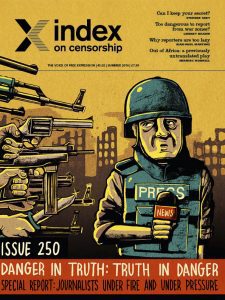
Index on Censorship’s summer magazine 2016
We’ll send you our weekly emails and periodic updates on our events. We won’t share your personal information with anyone outside Index.
You’ll also get access to an exclusive collection of articles from our landmark 250th issue of Index on Censorship magazine exploring journalists under fire and under pressure. Your downloadable PDF will include reports from Lindsey Hilsum, Laura Silvia Battaglia and Hazza Al-Adnan.[/vc_column_text][/vc_column][vc_column width=”1/2″][gravityform id=”20″ title=”false” description=”false” ajax=”false”][/vc_column][/vc_row][vc_row][vc_column][vc_separator color=”black”][/vc_column][/vc_row][vc_row][vc_column][vc_column_text]Protecting religious sensitivities at price of free expression
Many countries have legislation designed to quell religious tensions and any ensuing violence.
India, for example, has a Penal Code with provisions to protect “religious feelings”, making “acts” or “words” that could disturb religious sensitivities punishable by law. However, while such laws exist to address prevent sectarian violence their vagueness means that they can also be used by groups to shut down free expression. This opens up a question, which is when do states have the right to censor for public order reasons even if the actual piece of writing, art or public display is not a direct incitement to violence.
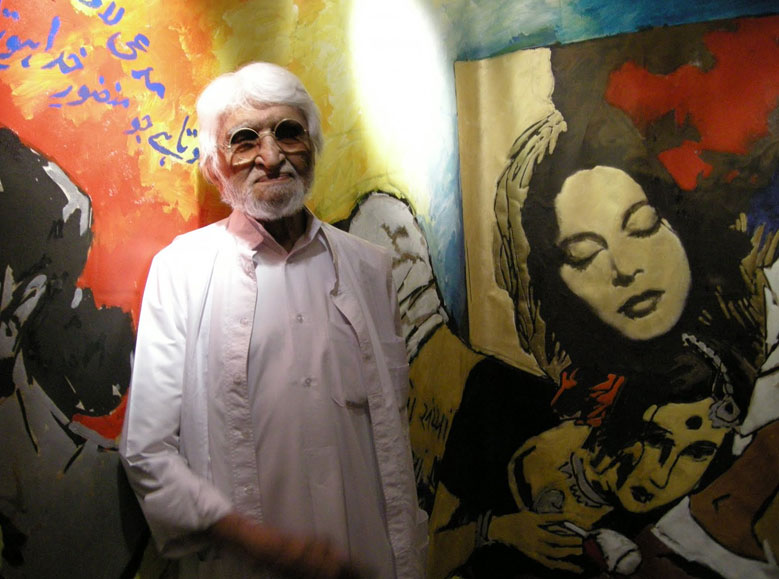
Indian artist and Index award winner was forced to leave his native India in the 1990s after being threatened for his work
In the 1990s, Indian artist and Index award winner MF Husain was the subject of a violent intimidation campaign after painting Hindu gods and goddesses naked. He received death threats and had his work vandalised. Hundreds of complaints were brought against the artist, leading to his prosecution under sections 295 and 153A of India’s Penal Code, which outlaw insulting religions, as well as promoting animosity between religious groups. Locally these laws are justified as an effort to control sectarian violence. While the cases against Husain were eventually thrown out, the spectre of new legal battles combined with violent threats and harassment pushed Husain to flee his home country. He never returned, and died in exile last year.
Across the world restrictions on free expression are imposed using laws designed to protect religious sensitivities.
Pakistan’s blasphemy laws are notorious for being abused to silence and persecute the country’s religious minorities. Although the country’s Penal Code has always had a section on religious offence, clauses added in the 1980s set a high price for blasphemy or membership of the Ahmadi sect of Islam — an Islamic reformist movement. These laws, including a possible death sentence for insulting the Muslim prophet Muhammad, have been slammed by civil society inside and outside of Pakistan.
A report issued in September by the Special Rapporteur on the promotion and protection of the right to freedom of opinion and expression, Frank La Rue, says that blasphemy laws should be repealed. Controls on free speech in order to protect religious sensibility seem to run parallel to controls on religion.
Globally, restrictions on religious expression have increased according to a report released last month by the Pew Research Center. In 2010, the study found that 75 per cent of the world’s population lived in countries where restrictions placed on religious practice were rated as either “high” or “very high”. The study found that the greatest restrictions on religion take place in the world’s most heavily populated countries — India, Egypt, Indonesia, Iran, and Russia stood out on the list.
Outrage and incitement to religious hatred
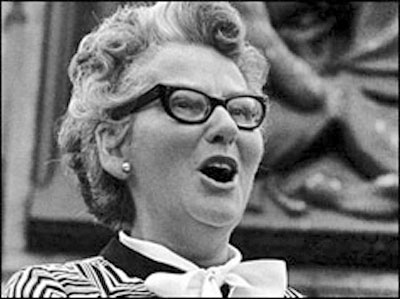
In 1977 Christian campaigner Mary Whitehouse successfully brought charges against the publishers of a magazine that printed a graphic sexual poem about Jesus Christ
In 2007, the UK introduced the offence of “incitement to religious hatred”, which some feared was merely a replacement for the scrapped blasphemy law, made more wide-ranging by covering not just Christianity but all religions. The last conviction under that law was the infamous 1977 Gay News case, where Christian campaigner Mary Whitehouse brought a successful private prosecution against the publishers of Gay News magazine for publishing a poem describing a Roman soldier’s fantasy of sex with Jesus Christ.
In the UK, one of the most pernicious means by which restrictions on free speech have grown tighter has been through the use of incitement laws, both incitement to hatred and incitement to violence and murder. In some cases, as in the outlawing of incitement to religious hatred through the Racial and Religious Hatred Act, the law is being used to censor genuine debate. In other cases, incitement law is being used to shut down protest, as in the convictions of Muslim protestors Mizanur Rahman and Umran Javed for inciting racial hatred and ‘soliciting murder’ during a rally in London against the publications of the Danish Muhammed cartoons. Over the past decade, the government has used the law both to expand the notion of ‘hatred’ and broaden the meaning of ‘incitement’. Much of what is deemed ‘hatred’ today is in fact the giving of offence. And should’t the giving of offence be viewed as a normal and acceptable part of plural society?
In 2009, Ireland created for the first time a specific blasphemy offence. This law states a person is guilty of blasphemy if
“he or she publishes or utters matter that is grossly abusive or insulting in relation to matters held sacred by any religion, thereby causing outrage among a substantial number of the adherents of that religion, and
(b) he or she intends, by the publication or utterance of the matter concerned, to cause such outrage.”
This wording was later used as a template for attempts to introduce the idea of “defamation of religion” as an offence at the United Nations. The attempt to introduce this concept failed, but the UN Human Rights Council did pass a resolution condemning “intolerance, negative stereotyping, stigmatisation, discrimination, incitement to violence, and violence against, persons based on religion or belief”.
On the other hand, according to Frank La Rue, quoted by Journalism & Intolerance said: “blasphemy is a horrible cultural phenomenon but, again, should not be censored or limited by criminal law. I would like to oppose blasphemy in general by being respectful, but that’s something you build in the culture and the traditions and the habits of the people, but not something you put in the criminal code. Then it becomes censorship.”
Crushing religious freedom
Other European countries have had their own free speech versus religion battle when a push towards bans on the veil or niqab began, infringing on choices of Muslim women. France’s controversial ban on the niqab went into effect last year. Offenders must pay a 150 € fine or take French citizenship classes. There have been similar discussions in the Netherlands, Denmark, the United Kingdom, and Belgium. Such bans are not restricted to Europe — in 2010 Syria banned face veils from university campuses. From 1998 – 2010, Turkey banned headscarves from university campuses. In fact, Turkey has a much wider ban on headscarves in public buildings, a ban the government faces difficulties overturning though it would like to. Just as troubling — countries like Iran and Saudi Arabia have strict dress codes for women that visitors must comply with as well.
Both enforced secularism and enforced religiosity constitute a form of censorship; the key word being “enforced” as opposed to “free”. Whether it is tackling enforced religion, religious offence, hatred and incitement to violence, or enforced secularism, only a constructive approach to free speech can genuinely guarantee freedom of conscience and belief, whether in one god, many or none.[/vc_column_text][/vc_column][/vc_row][vc_row][vc_column][vc_basic_grid post_type=”post” max_items=”12″ style=”load-more” items_per_page=”4″ element_width=”6″ grid_id=”vc_gid:1493908381135-56de588f-391f-0″ taxonomies=”78, 4880″][/vc_column][/vc_row]
15 Feb 2013 | Index Index
At least 17 prisoners of conscience are on hunger strike in Oman. They began the strike on 9 February at Muscat’s Samayel prison, and other detainees have since joined them, making the total number of hunger strikers 23. Six who were reported to be in a critical condition were taken to hospitals around the capital on 13 February. Yaqoob Al-Harith, a lawyer to seven of the original 17 refusing to eat said they are protesting against the time it is taking to transfer their cases to the supreme court to appeal their jail sentences. The have all been imprisoned for between six and 18 months. The free speech defenders, political activists and civil society representatives were jailed under charges of cyber crimes, illegal assembly, violating communications regulations and insulting ruler Sultan Qaboos on online social networks. Relatives of those imprisoned wrote to the National Human Rights Commission on 10 February and have appealed to the Omani authorities to have the detained released.

Iranian opposition candidate Mirhossein Mousavi has been under house arrest for two years
Two daughters of a former presidential candidate held under house arrest for nearly two years have been arrested in Iran. Zahra and Narges Mousavi, daughters of Mirhossein Mousavi, Iranian prime minister in the 1980s, were arrested by security forces on February 11. Along with Mousavi’s third daughter, they had written in a statement that authorities had denied Mousavi and his wife Zahra Rahnavard access to their children for weeks. Mousavi and Rahnavard were placed under house arrest along with opposition figure Mehdi Karroubi and his wife Fatemeh, after they called for demonstrations to support the Arab uprisings across the region in February 2011. The Islamic Republic is facing a presidential vote in June, and hardliners have accused opposition leaders of plotting a second sedition after the last protests were crushed by security forces. They have also called for the execution of both men, but the government are choosing to keep them in solitary confinement.
Saudia Arabia’s minister for media and culture has confirmed that a range of government bodies have been censoring Twitter, reports on 13 February said. Abdel Aziz Khoga called on Saudi citizens to ”raise their awareness” and monitor their social media activity more carefully, as it was proving increasingly difficult to monitor the three million Twitter subscribers around the kingdom. Under the Sunni monarchy, writer Turki Al-Hamad is one of many journalists in prison under blasphemy charges. He was arrested for insulting Islam in January, after he accused radical Islamists of corrupting Prophet Mohammad’s “message of love” in a Tweet in December 2o12. Online activist Raif Badawi was arrested in June 2012 and was charged with apostasy for his tweet, a sentence which carries the death penalty.
On 14 February, two Nigerian journalists appeared in court for criticising the government’s polio campaign. Yakubu Fagge and Mubarak Sani were charged with criminal conspiracy, abetment, defamation of character, obstruction of a public officer carrying out his duty, intentional insult, and incitement to violence. They plead guilty before judge Ibrahim Bello during their appearance before a senior magistrate court in Gyadi Gyadi, Kano. The pair were arrested after hosting a radio show on Wazobia FM on 6 February, where they alleged the government had forced parents to immunise their children against polio, claiming officials were abusing their power. Fagge and Sani have been granted bail with two sureties each at NGN 100, 000, on the condition the surities are community leaders or heads of department of government organisations. The case was adjourned until 13 March.






